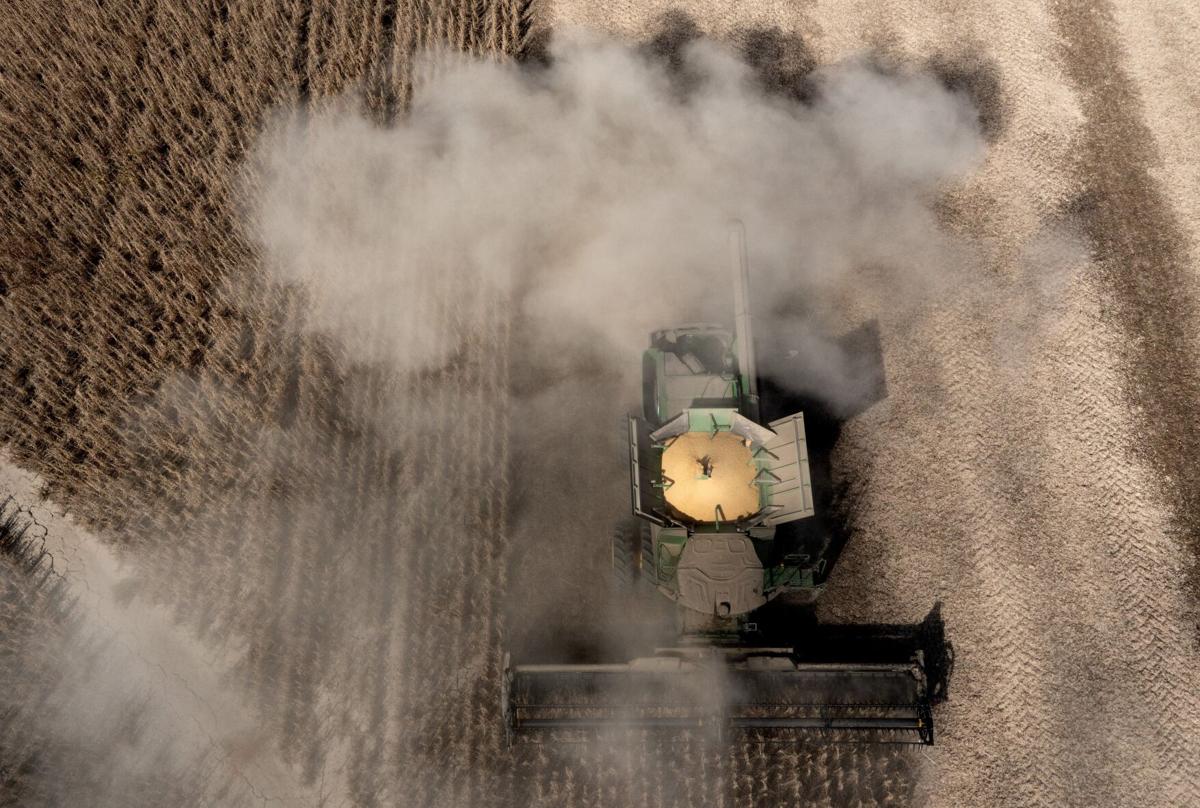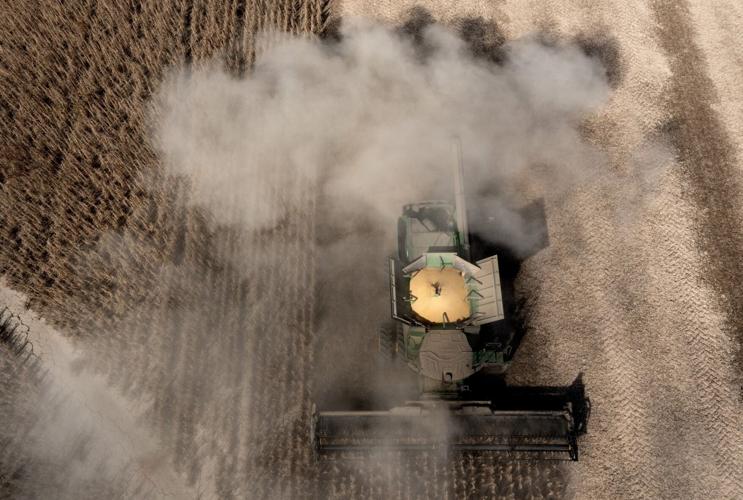WEST ALTON ŌĆö Dust clouds billowed as David Bonderer watched his son maneuver the familyŌĆÖs combine to harvest soybeans on a recent fall afternoon.
Bonderer, president of Saale Farm & Grain Co., has been crunching numbers to figure out how much the farm will earn from its 2,500 acres of corn and soybeans. He and other Missouri farmers say theyŌĆÖre worried that President Donald TrumpŌĆÖs trade war, particularly with China, will cost them reliable markets for their crops.
For months now, Trump has threatened, increased, paused and changed tariffs on foreign countries in an effort to reshape the United StatesŌĆÖ trade status. The added levies have impacted a wide array of U.S. businesses, from beer to chocolate to furniture to Christmas toys ŌĆö and prompted retaliatory tariffs on U.S. exports, like soybeans and grain.
People are also reading…
Recently, senior Trump administration officials have said Trump is poised to announce a bailout of at least $10 billion for crop farmers facing tariff-related financial strain. No details have been released. But producers like Bonderer say potential aid wouldnŌĆÖt address the larger market consequences of the tariffs.
ŌĆ£Typically farmers would rather see higher prices and would rather build relations with China,ŌĆØ Bonderer said. ŌĆ£WeŌĆÖre in it for the long haul. A bailout is a short-term fix, not a long-term fix.ŌĆØ
Last year, China bought over 105 million tons of the legume from the U.S., making it the countryŌĆÖs biggest soybean buyer. This year, China has yet to place an order, turning instead to Brazilian suppliers ŌĆö leaving U.S. soybean producers searching for new buyers amid lower prices.

Eric Saale unloads soybeans from a truck into the silos at Saale Farm & Grain in West Alton on Thursday, Oct. 9, 2025.
Agriculture is MissouriŌĆÖs top economic driver, with almost 86,000 farms and over 400,000 farm workers across the state, according to the Missouri Department of . ItŌĆÖs one of the countryŌĆÖs largest growers when it comes to plants such as rice, corn, cotton, soybeans and peanuts.
Saale Farm & Grain operates two grain elevators and sells agricultural seed, chemicals and supplies.
Customers have been calling Bonderer, asking if he thinks they should wait to sell their crops, how much fertilizer they should purchase for next year and so on. Bonderer said he has no idea what to tell them.
ŌĆ£I donŌĆÖt got a crystal ball,ŌĆØ he said. ŌĆ£How can you give someone advice when itŌĆÖs unpredictable?ŌĆØ
Across the state, about 70 miles north of Kansas City near Maysville, Bryant Kagay has been spending most of his days alone, sitting behind the wheel of his combine. He has about 2,400 acres of crops to reap, dry, transport and sell.
Kagay is a fourth-generation farmer raising cattle in addition to growing soybeans, corn and wheat. He doesnŌĆÖt yet know how the tariffs will affect his bottom line, but the idea of a bailout doesnŌĆÖt sit well with him.
ŌĆ£When the government comes out with a payment, I think it just kicks this can down the road,ŌĆØ said Kagay, who voted for Trump. ŌĆ£I just hate it. I think itŌĆÖs a very poor strategy. I know why heŌĆÖs doing it, but I still donŌĆÖt agree with it.ŌĆØ
Blake Hurst, a soybean, corn and flower farmer in northwestern Missouri, said that usually about a quarter of his entire crop yield gets sent to China. Hurst said he will sell what he can to local grain elevators and then store the rest in silos. HeŌĆÖs unsure how much money heŌĆÖll make this year.
The effect of tariffs on market prices is worse than what he anticipated when Trump began to announce the blanket levies in the spring, Hurst said. Currently, there are active tariffs on over 70 countries, ranging from 10% to 50%. Earlier this spring, TrumpŌĆÖs tariffs on China reached 145% but that number eventually dropped to 30%. The U.S. and China had been in a 90-day trade truce ŌĆö but on Friday Trump announced that he would levy new 100% tariffs on China starting Nov. 1, if not before.
ŌĆ£Our trade policy right now makes no sense to me as a farmer,ŌĆØ Hurst said. ŌĆ£No, I donŌĆÖt want the tariff money sent to me as a payment. I want to be able to sell my damn soybeans.ŌĆØ
Doing the math
Laurence Ales, economics professor at Carnegie Mellon University in Pittsburgh, said that agriculturally, this was a good summer for farmers, which comes as a ŌĆ£mixed blessing.ŌĆØ
ŌĆ£Now you have depressed exports, excess supply and now youŌĆÖre still having the downward pressure on prices, hence, on income,ŌĆØ Ales said. ŌĆ£You have an agricultural cycle superimposed with an economic and trade cycle. ThatŌĆÖs problematic.ŌĆØ

Soybeans fall through the air as they are off-loaded from a combine into a truck at Mintert Farms in West Alton on Thursday, Oct. 9, 2025.
Corn are about $4 a bushel for October, about 50% less than the $8 high they reached in 2022. For , the current rate is about $10 a bushel, after running about $15 a bushel three years ago. Wheat prices have dropped to $5 a bushel, down from about $12 in 2022.
Kagay said he usually sells to local grain processors and soybean elevators. His work is connected to a global market ŌĆö if China isnŌĆÖt buying from the U.S., his farm suffers.
HeŌĆÖs pre-sold very little this year, Kagay said, so his farm is at risk if prices continue to drop. He could store the harvested crops until prices go up again, he said, but that wouldnŌĆÖt make sense ŌĆö he has workers and bills to pay now.
According to s Ag Economy Barometer, farmers have become less optimistic about tariffs helping the U.S. economy and say that they expect weaker financial performance this year, compared to 2024.
Out of the 400 U.S. agriculture producers surveyed in September, about half said that increased use of tariffs by the U.S. will strengthen the domestic agricultural economy in the long run. This is down from the 63% who responded positively in June and the 70% in April.
Usha Haley, a business professor at Wichita State University, said tariffs have created a two-prong problem for U.S. farmers. Farms are getting less money for their crops, while also facing higher costs for machinery parts, fertilizer and seed.
ŌĆ£Farmers, especially, are in the crosshairs, and theyŌĆÖre feeling several interlocking pressures,ŌĆØ Haley said. Farmers operate on slim margins, she said, and smaller farms are particularly sensitive to price swings.
Economists warn that these financial challenges will eventually trickle down to rural communities, especially in the Midwest, which has over 127 acres of agricultural land. Community grocery stores, restaurants and services will feel the pinch, Haley said.
Farmers are already planning for next year.
To avoid markups from steel tariffs, Hurst said he has rebuilt his 14-year-old combine, instead of spending half a million dollars on a new one.
Similarly, Kagay said his farm is slowing equipment purchases, focusing on repairing and refurbishing what he already has. And, instead of fertilizer, heŌĆÖll use the manure compost from the farmŌĆÖs beef operations.
ŌĆ£I mean, thereŌĆÖs some things we canŌĆÖt cut. You have to have so much seed, you just canŌĆÖt avoid it,ŌĆØ Kagay said. ŌĆ£Ultimately, what we can control better is watching our input expenses to try to spend less.ŌĆØ
The farming industry is a cyclical one, according to producers. ItŌĆÖs not unusual to have three or four really good years followed by a number of lean years. Hurst said heŌĆÖs weathered financially tough years before and is prepared to do it again. But TrumpŌĆÖs unpredictable tariff changes are making this cyclical downturn ŌĆ£much worse,ŌĆØ Hurst said.
ŌĆ£ItŌĆÖs going to be very tight,ŌĆØ Hurst said. ŌĆ£These are not profitable prices. These are not prices that keep people in farming. In other words, thereŌĆÖs very little incentive, except for thatŌĆÖs all I know to do.ŌĆØ
U.S. soybean farmers face a glut as China slashes purchases from nearly 1B to 200M bushels, driving prices down. With exports collapsing, Trump is weighing up to $14B in tariff-funded aid to support struggling growers.




















